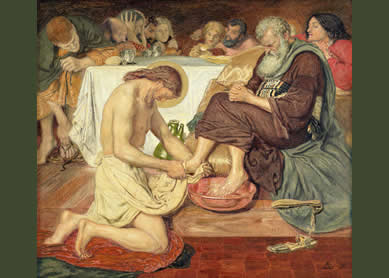When do the movements that form around the memory and the message of Jesus of Nazareth become something recognizably other than, different from, and even hostile toward Judaism? Some sort of clarity on this complicated social and historical question might be gained by noting the first appearance of the word “Christian,” which occurs only in the early second century. A Latin-stem term that designates a “follower of Christ,” “Christian” rests on the Greek christos, the word for “anointed.” In a pagan context, it would connote someone, whether entering a wrestling match or exiting a bath, who would have been rubbed down with oil. Only within a Greek-speaking Jewish context would christos indicate someone with a special religious and social status as “God’s anointed one,” maschiach in Hebrew. In ancient Jewish tradition, priests and kings were anointed into office; and “God’s anointed” became especially associated with the idea of a kingly figure of Davidic lineage. Linked with the figure of Jesus, the term christos proclaimed his status as “messiah.” At what point, then, did Christ-followers start to distinguish themselves with the term “Christian”?
Was Jesus a “Christian”? Was he founding a new religion distinct from Judaism?
The word “Christian” is nowhere in the gospels. And in those texts, the figure of Jesus is nowhere depicted as standing outside of his native religion. The gospels individually vary their respective portraits of Jesus, but they all present him as someone who inhabits the world of late Second Temple Judaism. Jesus frequents synagogue gatherings on the Sabbath and the temple in Jerusalem during the pilgrimage holidays (e.g., Sabbath: Mark 1:21, Mark 1:39, Mark 3:1-2; Passover: John 2:13, John 12:12; Sukkot: John 7:2, John 7:10; “Hanukkah”: John 10:22). He wears the fringes (tzitziot) mandated in Deuteronomy to remind the wearer of God’s commandments (Mark 6:56, cf. Deut 22:11-12), and he refers to the law as the touchstone of piety and ethics (Mark 10:19, Mark 12:28-31). Jesus orders a cured leper to fulfill the rites of purification detailed in Leviticus (Mark 1:40-44); later, he enters Jerusalem in the week before Passover, presumably to undergo the purifications required for the feast (Mark 11). The meat that was the ritual centerpiece of the Passover meal depicted in Mark, Matthew, and Luke as Jesus’s “last supper” could only have been procured by a disciple’s sacrificing a lamb at the temple (Mark 14:16).
In his controversies with scribes and Pharisees, the gospels’ Jesus offers his interpretations of ways to keep the Sabbath, to honor God, and to participate in temple worship. The parties argue precisely because they share a common commitment to what is religiously important: argument implies inclusion. Gentiles, whether sympathetic or hostile, do not loom large as a focus of Jesus’s mission, and Jesus at no point urges worship of himself. Those characteristics of later Christianity—a predominantly gentile population; a reverence for the figure of Jesus as a divine intermediary between heaven and earth; a measured hostility toward Jews and Judaism—do not appear in the gospel stories. For these formations, we must look outside of Jesus’s own lifetime and predominantly Jewish location, to the movements that bloomed, postresurrection, within diaspora Mediterranean cities.
Was Paul a “Christian”? Was he founding a new religion distinct from Judaism?
The earliest direct testimony that we have from a follower of Jesus comes, mid-first century, from the letters of his apostle Paul. Paul identifies himself as an Israelite, a Pharisee, a Hebrew born of Hebrew parents, and member of the tribe of Benjamin (Phil 3:5; cf. Gal 1:14). Paul refers to ethnic Israel as “God’s people” (Rom 11:1), and he identifies this people as his “kinsmen” (Rom 9:4). In this same passage of Romans, Paul praises God for the privileges conferred upon his fellow Israelites: their sonship; the divine presence in Jerusalem (“glory” in the RSV); the covenants; the giving of the Torah; the cult of sacrifice (“worship” in the RSV, but the Greek word means “cult,” another nod to the Jerusalem temple); the promises and the patriarchs; and a blood-relationship to the messiah (Rom 9:4-5). In short, Paul thinks of himself as a Jew; and he thinks of “Israel” as Jewish Israel.
Paul’s conviction that Jesus, raised and shortly returning, was God’s messiah, compelled Paul’s gentile mission, in which he sought to turn pagans from the worship of their native gods to an exclusive commitment to Israel’s god. To this degree, Paul urged these gentiles to “Judaize”: no other gods and no idols were the first two commands of the Sinai covenant (Exod 20:11-12). Paul, like most Jews, held that circumcision and other Jewish practices were not incumbent on these gentiles. But this gentile policy tells us nothing about Paul’s own level of Jewish observance, which he himself deemed “flawless” (Phil 3:6). Finally, Paul expected that the population of God’s kingdom would contain both gentiles (“the fullness of the nations”) and Jews (“all Israel,” Rom 11:25-26; cf. Rom 15:9-12). If Jesus, then, had conceptualized his own mission to Israel as the beginning of a new religion, his apostle Paul knew nothing of this.




